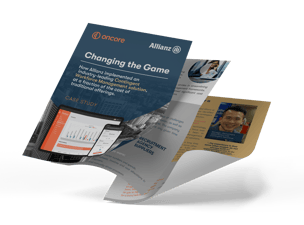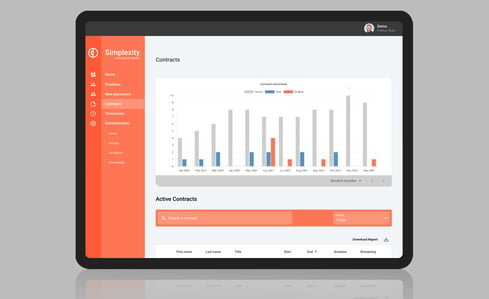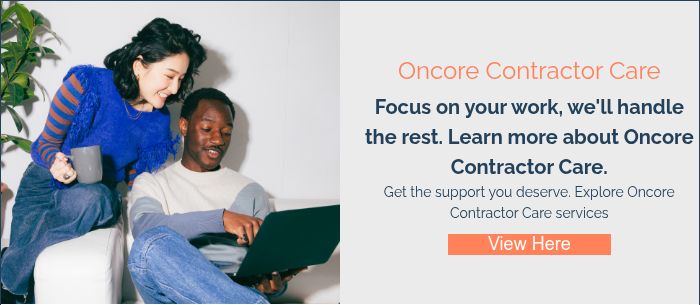HR’s Responsibility to Support Non-Permanent Talent
For HR leaders, the takeaway is clear: your duty of care must extend to non-permanent talent. Traditionally, contractors have sometimes been left on the sidelines of corporate well-being programs, but that approach is no longer viable (or ethical). Contingent workers now comprise a critical slice of the workforce, and their performance is tightly linked to business outcomes, so their well-being counts. Ignoring this cohort’s needs can have real costs: disengagement, turnover mid-project, or lower productivity due to burnout.
One major gap to address is the lack of benefits and support structures for contractors. In some regions, contractors themselves highlight this as a top stressor – for instance, over half of contractors in North America (54%) and Asia (63%) say the lack of employer-provided benefits creates significant stress. Think about that: many contingent staff worry about getting sick or struggling silently because they don’t have the same safety nets as employees. HR leaders should work to close this gap. That means finding ways to offer mental health resources and wellbeing support to contractors, even if they aren’t on your direct payroll. The good news is that it’s very possible to do so, often through partnerships or vendor programs.
Tip: Treat contractors as an integral part of your team when it comes to well-being. Wherever possible, include contractors in Employee Assistance Programs (EAPs), wellness initiatives, and training on work-life balance. Leading organisations are starting to normalise mental health support for all workers – for example, integrating wellbeing talks into onboarding and making counselling services available on a voluntary, confidential basis. Similarly, managers who supervise contractors should be coached to monitor workload and encourage reasonable boundaries (no 10 pm emails expected!). The aim is to create a culture where asking for help is OK and support is readily visible, regardless of a worker’s employment status. Legally, you should review any co-employment considerations, but providing access to wellbeing resources is generally low-risk and high-reward. Ultimately, if your workplace can help every team member, permanent or contingent, to thrive, you’ll reap the benefits in engagement and results.
Oncore’s Commitment to Contractor Care
As a contingent workforce specialist, Oncore has made contractor wellbeing a core focus, offering a blueprint for how to support non-permanent staff. Oncore’s own data and 25+ years of experience (the company was founded by former contractors) have shown that taking care of people pays off. In fact, Oncore boasts an exceptionally high contractor satisfaction, with an NPS of 73 from its contractors, a result of “our commitment to service excellence” and caring for the contractor’s entire journey. So what does this look like in practice? Oncore’s Contractor Care program provides several key wellbeing initiatives:
- Personalised Onboarding & Check-ins: Every contractor gets an introductory welcome call before their contract starts, plus regular 1-on-1 check-in calls from Oncore’s team throughout their engagement. These personal touchpoints ensure that contractors never feel like “just a number.” It’s an opportunity to surface any issues early - whether it’s workload concerns, project fit, or personal stress and to make the contractor feel supported from day one. Consistent, friendly communication goes a long way in easing the anxiety that can come with a new contract role.
- Access to an Employee Assistance Program (EAP): All Oncore contractors have access to confidential counselling and mental health resources via a professional EAP service. Through Oncore’s partnership with Connect Psych, contractors can connect with a qualified therapist online, on-demand, anytime they need, from wherever they feel comfortable. This means even if a contractor is working remotely or is between gigs, they aren’t on their own – they have somewhere to turn for psychological support. Importantly, the EAP is free for the individual and totally private, lowering the barrier for contractors to seek help early before issues escalate.
- Community and Wellbeing Benefits: Oncore recognises that contractors miss out on the office camaraderie and perks that full-timers might get. To fill that gap, they offer contractor community events and a lifestyle benefits program. Contractors can join a dedicated online community (even a Facebook group) to share experiences and advice, fostering a sense of belonging. Oncore also provides perks like discounted health insurance through Bupa and a wellbeing app via Flare, which offers guidance on healthy living and hundreds of retail discounts. These benefits help contractors feel valued and looked after beyond just their day-to-day work.
By investing in these kinds of initiatives, Oncore sends a powerful signal: contractor wellbeing matters. The result is not only happier, healthier contractors but also better outcomes for clients. When contingent workers have less to worry about (whether it’s getting paid on time or having someone to call in a tough moment), they can focus on delivering their best work. It’s a win-win that more organisations are starting to emulate. Oncore’s approach shows that with some creativity and commitment, you can provide a holistic support system for contractors - one that rivals what permanent employees receive.
Wellbeing: A New Differentiator in Contractor Engagement
Looking ahead, it’s becoming evident that workplace wellbeing is a key differentiator in attracting and engaging top contractor talent. The contracting market in 2025 is extremely competitive – skilled contractors often juggle multiple offers and can choose to work with the companies (or recruitment agencies) that best align with their values and needs. Increasingly, those needs go beyond just a good day rate. Contractors are prioritising the work environments and support structures that will enable them to sustain a long-term career. According to Oncore’s latest survey, a whopping 78% of contractors say a company’s culture is “very important” in deciding whether to take a role. And the most valued aspect of culture? Open communication and collaboration (cited by 80%), which ties directly into feeling supported and included. In short, if a client organisation treats contractors like an afterthought or a recruitment agency pushes placements without considering wellbeing, the top contractors will walk.
On the flip side, companies that embed wellbeing into their contractor experience will gain a competitive edge. Offering flexible work options (hybrid is now preferred by 64% of contractors), encouraging reasonable hours, respecting boundaries, and providing mental health support can dramatically enhance a contractor’s loyalty and output. As one global report put it, understanding the “emotional truth behind the promise of flexibility” has made mental wellness mission-critical in the gig economy. Forward-thinking organisations realise that caring for contractors is not just a nice gesture but a strategic imperative to secure the talent they need.
So what can organisations do to adapt? Here are a few steps:
- Incorporate Wellbeing into Contractor Programs: Make wellbeing part of your contingent workforce strategy. For example, extend your corporate wellness initiatives to contractors or partner with your payroll/contractor management providers to offer services like counselling, financial coaching, or health webinars to non-permanent staff. Ensure contractors are invited to any company wellness days or talks. Small inclusions can have a big impact on how valued they feel.
- Train Managers and Set Expectations: Educate hiring managers and team leaders on the importance of treating contractors with the same care as employees. This means checking in on their workload and stress levels, giving feedback and guidance, and being mindful of not creating a “second-class” citizen vibe. Also, clarify expectations with contractors around working hours and communication. Many contractors are happy to go the extra mile when needed, but no one can sprint indefinitely - as one expert noted, “good leaders know people can’t run marathons all the time”. Encourage a sustainable pace.
- Foster an Inclusive, Open Culture: Because contractors often come and go, it’s easy for them to feel disconnected. Combat this by fostering a team culture where communication is open and inclusive for everyone on a project. Solicit contractors’ input in meetings, loop them into team events, and acknowledge their contributions publicly. If a contractor is struggling, create an environment where they feel safe speaking up or using available support. An inclusive culture that “puts the human in HR” isn’t just for full-timers - it should extend to anyone doing work for you. This sense of belonging and respect can significantly boost a contractor’s engagement and well-being.
- Leverage Experts in Contractor Care: You don’t have to do it all alone. Consider partnering with firms that specialise in contractor management and care (like Oncore), which have established programs for supporting contingent workers. They can provide ready-made solutions, from onboarding assistance to EAP access, ensuring your contractors are looked after without heaps of internal admin. By outsourcing the heavy lifting of contractor care, HR leaders can both reduce risk and improve the contractor experience in one go.
A Sustainable Future: Wellbeing as a Cornerstone of Contractor Engagement
In 2025 and beyond, the organisations that thrive will be those that recognise everyone’s well-being as non-negotiable. This isn’t a mere “feel-good” sentiment - it’s increasingly a make-or-break factor in workforce strategy. For contractors who have chosen a more fluid career path, having solid support for their mental health and work-life balance may determine whether they stick with a client or move on to greener pastures. By championing initiatives that keep contractors healthy, happy, and motivated, companies can differentiate themselves as clients of choice in the gig economy. They’ll attract more in-demand specialists and see better outcomes on their projects as a result.
Oncore’s experience has shown that caring for contractors deepens their engagement and loyalty, which ultimately benefits all parties. As the war for talent continues, it’s worth remembering that well-being could be your secret weapon. Organisations that cultivate a reputation for looking after their people (permanent or contingent) will not only mitigate the current wellness crisis – they’ll build a resilient, committed workforce ready to tackle the challenges ahead. In the end, supporting contractor wellbeing isn’t just about avoiding burnout; it’s about empowering a diverse, agile workforce to do their best work. And that is a differentiator no business can afford to ignore in the evolving world of work.












_11zon%20(1).jpg?width=302&height=124&name=linkedin-sales-solutions-vqWWOnA6--M-unsplash%20(2)_11zon%20(1).jpg)









